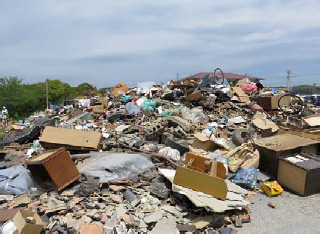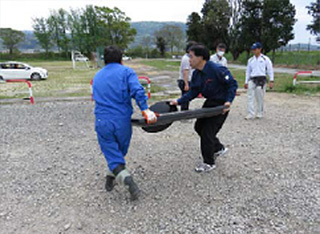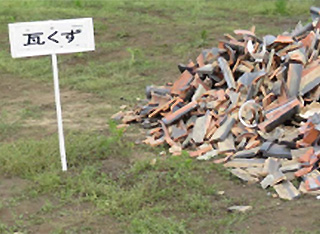- Waste management in Japan
- Circular economy in Japan
- Waste management in Asia
- Disaster waste management
Practical Ideas to Facilitate Sorting of Disaster Waste at Temporary Storage Sites
Natural disasters generate a massive amount of disaster waste of many different types in affected areas in a short time. After immediate post-disaster rescue operations, disaster waste needs to be removed from the living environment of affected people as soon as possible so that they can restore their lives quickly. For that purpose, disaster waste is carried into places called "temporary storage sites (TSSs)” and accumulated there. As the name indicates, TSS is a place with a certain amount of space for “temporarily” keeping disaster waste that people bring in. The disaster waste needs to be properly sorted at these sites to facilitate its subsequent treatment processes such as recycling and landfilling. Safety and environmental aspects should also be ensured in the storage and management of disaster waste at these sites. This article will introduce a challenge faced at TSSs regarding proper sorting of disaster waste after a recent disaster event, and some actions that NIES support team suggested to improve the situation.
At the time of the 2016 Kumamoto Earthquakes, NIES support team visited some municipal TSSs two days after the first quake of 14 April. Some disaster debris was already brought from houses and buildings into these sites, and starting to pile up in a mixed and unsorted state. In towns, there were public announcements from disaster communication radio systems requesting people to sort disaster waste by types. When NIES support team visited the TSSs however, due to shortage of staff to manage operations, there was no guidance for residents carrying disaster waste into the sites on trucks to sort the waste there.
Therefore, NIES support team suggested the following practical ideas to facilitate the sorting of the disaster waste at TSSs and to support the municipalities that manage the sites. Even in the above-mentioned cases, proper way to sort the disaster waste can be shown by initially making small sample piles by type. The residents unloading the waste can easily follow the example. Other ideas to facilitate the sorting included setting standing signboards, each with a name of the type of waste, beside each pile, and placing a layout plan at the entrance of TSSs to show specific spots, proper sequential order and route for discharging different types of waste.
It is difficult to give due consideration to the sorting of disaster waste in a chaotic situation after a disaster event. Nevertheless, sorting the waste when it is discharged is more effective than doing the same later from the large piles in a mixed state. The sorting at an early stage would save time, effort, and money if we consider the entire processes of disaster waste treatment and recycling. Moreover, the proper sorting of disaster waste can minimize the problems of pests, vermin, and odors. It can also reduce the risk of fire caused by spontaneous ignition of combustible items in the waste at TSSs. In sum, the sorting of disaster waste offers the advantage of strengthening its storage and management from environmental and safety viewpoints.
 Disaster waste carried into TSSs in a mixed state
Disaster waste carried into TSSs in a mixed state Samples being set to facilitate the sorting
Samples being set to facilitate the sorting
For more information
- National Institute for Environmental Studies, Platform of Disaster Waste Information (2016) Report on NIES D.Waste-Net’s activities after the Kumamoto Earthquakes (in Japanese)


